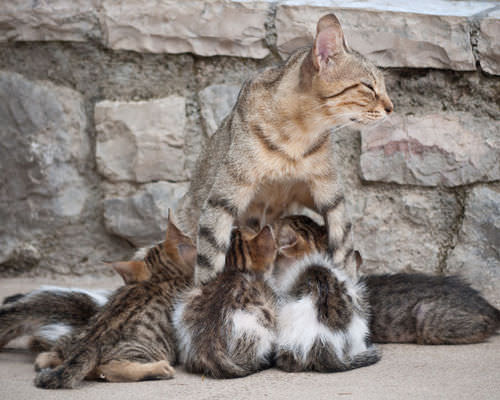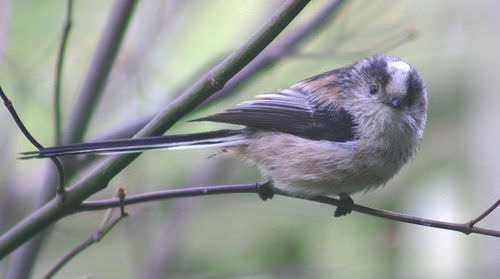生命的特征
Section outline
-
Is fire alive?
::火是活的吗?Fire can grow. Fire needs fuel and oxygen. But fire is not a form of life, although it shares a few traits with some living things. How can you distinguish between non-living and living things?
::火可以燃烧,火需要燃料和氧气。但火不是生命的一种形式,尽管它与一些生物有共同的特性。你怎能区分非生物和生物?The Characteristics of Life
::生命的特征How do you define a living thing? What do mushrooms , daisies, cats, and bacteria have in common? All of these are living things, or organisms . It might seem hard to think of similarities among such different organisms, but they actually have many properties in common. Living organisms are similar to each other because all organisms evolved from the same common ancestor that lived billions of years ago.
::如何定义一种生物?蘑菇、菊花、猫和细菌有什么共同之处?所有这些都是生物,或生物体。似乎很难想象这些不同生物体之间的相似之处,但实际上它们有许多共同特性。 活生物体彼此相似,因为所有生物体都从数十亿年前的同一种共同祖先中演变而来。All living organisms:
::所有活生物体:- Need energy to carry out life processes.
::需要能量来完成生命过程
- Are composed of one or more cells .
::由一个或多个单元格组成。
- Respond to their environment.
::回应他们的环境。
- Grow and reproduce.
::生长再繁殖
- Maintain a stable internal environment.
::维持稳定的内部环境。
Living Things Need Resources and Energy
::生活需要资源和能源Why do you eat everyday? To get energy. Energy is the ability to do work. Without energy, you could not do any "work." Though not doing any "work" may sound nice, the "work" fueled by energy includes everyday activities, such as walking, writing, and thinking. But you are not the only one who needs energy. In order to grow and reproduce and carry out the other process of life, all living organisms need energy. But where does this energy come from?
::为什么每天吃东西?为了获得能源,能源是工作的能力。没有能源,你就不能做任何“工作 ” 。虽然不做任何“工作”听起来可能听起来不错,但由能源推动的“工作”包括日常活动,如行走、写作和思考。但并非只有你才需要能源。为了种植和繁殖以及实现生命的其他过程,所有生物都需要能源。但这种能源来自何处?The source of energy differs for each type of living thing. In your body, the source of energy is the food you eat. Here is how animals , plants, and obtain their energy:
::每种生物的能量来源各有不同。在你们的身体里,能源来源是你们所吃的食物。这是动物和植物的本源,你们得享受它们的能量。- All animals must eat in order to obtain energy. Animals also eat to obtain building materials. Animals eat plants and other animals.
::动物也吃建筑材料,动物吃植物和其他动物。
- Plants don’t eat. Instead, they use energy from the sun to make their "food" through the process of .
::植物不吃。 相反,它们利用太阳的能量通过过程制造“食物 ” 。
- Mushrooms and other fungi obtain energy from other organisms. That’s why you often see fungi growing on a fallen tree; the rotting tree is their source of energy ( Figure ).
::蘑菇和其他真菌从其他生物中获取能量。 这就是为什么你经常看到真菌在秋树上生长;腐烂的树是它们的能量来源(图 ) 。
Since plants harvest energy from the sun and other organisms get their energy from plants, nearly all the energy of living things initially comes from the sun.
::自从植物收获太阳和其他生物的能量 从植物获得能量, 几乎所有生物的能量 最初都来自太阳。Orange bracket fungi on a rotting log in the Oak Openings Preserve in Ohio. Fungi obtain energy from breaking down dead organisms, such as this rotting log.
::俄亥俄州橡树开阔保护区的腐烂原木上的橙色括号真菌。真菌通过破碎死亡生物获得能量,比如这个腐烂原木。Living Things Are Made of Cells
::以细胞为生If you zoom in very close on a leaf of a plant, or on the skin on your hand, or a drop of , you will find cells. Cells are the smallest structural and functional unit of all living organisms. Most cells are so small that they are usually visible only through a . Some organisms, like bacteria, plankton that live in the ocean, or the Paramecium, shown in Figure are unicellular, made of just one cell. Other organisms have millions, billions, or trillions of cells.
::如果你非常接近植物的叶子或手上的皮肤或一滴细胞,你会发现细胞。细胞是所有活生物体中最小的结构和功能单位。大多数细胞都非常小,通常只能通过一个可以看见。图中显示的一些生物,如细菌、生活在海洋中的浮游生物或Paremicium,是由一个细胞组成的单细胞。其他生物有数以百万计、数十亿计或数万亿个细胞。All cells have at least some structures in common, such as ribosomes , which are the sites where proteins are made. All cells also have and proteins . You can clearly see the blue in these cells ( Figure ). The nucleus can be described as the "information center," containing the instructions (DNA) for making all the proteins in a cell, as well as how much of each protein to make. The nucleus is also the main distinguishing feature between the two general categories of cell; cells that lack a nucleus are known as prokaryotic cells .
::所有的细胞至少有一些共同结构, 比如, 血清, 它们是蛋白质生成的场所。 所有细胞都有和蛋白质。 您可以清楚地看到这些细胞中的蓝色( 图 ) 。 核心可以描述为“ 信息中心 ” , 包含细胞中所有蛋白质生成的指令( DNA ) , 以及每个蛋白质的多少。 核也是两大类细胞的主要区别特征; 缺少核的细胞被称为蛋白质细胞 。Although the cells of different organisms are built differently, they all have certain general functions. Every cell must get energy from food, be able to grow and divide, and respond to its environment. More about cell structure and function will be discussed in additional concepts.
::尽管不同生物体的细胞结构不同,但它们都具有某些一般功能。 每个细胞都必须从食物中获得能量,能够生长和分裂,并应对其环境。 关于细胞结构和功能的更多内容将在其他概念中讨论。These cells show the characteristic nucleus in blue. This image has been magnified 1000 times its real size.
::这些单元格显示蓝色的特性核。 这个图像被放大了1000倍 其实际大小 。This Paramecium is a single-celled organism.
::是一种单细胞生物Living Organisms Respond to their Environment
::应对其环境的生物体All living organisms are able to react to something important or interesting in their external environment. For example, living organisms constantly respond to their environment. They respond to changes in light, heat, sound, and chemical and mechanical contact. Organisms have means for receiving information, such as , ears, taste buds , or other structures.
::所有活生物体都能够对其外部环境中的重要或有趣的事物作出反应,例如,活生物体不断对环境作出反应,它们能对光、热、声音、化学和机械接触的变化作出反应。生物体有接收信息的手段,如耳朵、味蕾或其他结构。Living Things Grow and Reproduce
::成长和繁衍All living things reproduce to make the next generation. Organisms that do not reproduce will go extinct. As a result, there are no species that do not reproduce ( Figure ). Some organisms reproduce asexually ( asexual reproduction ), especially single-celled organisms, and make identical copies (or clones) of themselves. Other organisms reproduce sexually ( sexual reproduction ), combining genetic information from two parents to make genetically unique offspring .
::所有生物都可繁殖下一代。不繁殖的生物体会灭绝。因此,没有物种可以不繁殖(图 ) 。有些生物体会性繁殖(性繁殖 ) , 特别是单细胞生物体, 自己复制(或克隆 ) 。其他生物体会繁殖性繁殖(性繁殖 ) , 结合双亲的遗传信息, 形成基因上独特的后代。Like all living things, cats reproduce to make a new generation of cats.
::像所有生物一样 猫繁殖来制造新一代的猫Living Things Maintain Stable Internal Conditions
::维持稳定的内部条件When you are cold, what does your body do to keep warm? You shiver to warm up your body. When you are too warm, you sweat to release heat. When any living organism gets thrown off balance , its body or cells help it return to normal. In other words, living organisms have the ability to keep a stable internal environment. Maintaining a balance inside the body or cells of organisms is known as . Like us, many animals have evolved behaviors that control their internal temperature. A lizard may stretch out on a sunny rock to increase its internal temperature, and a may fluff its feathers to stay warm ( Figure ).
::当你寒冷的时候,你的身体会怎样保持温暖?你颤抖,让你的身体暖和起来。当你太热的时候,你就会冒汗释放热量。当任何生物体被抛离平衡时,它的身体或细胞会帮助它恢复正常。换句话说,生物体有能力保持稳定的内部环境。保持身体或生物体细胞内部的平衡是众所周知的。和我们一样,许多动物已经演化了控制内部温度的行为。蜥蜴可以伸展在阳光灿烂的岩石上,以提高其内部温度,还可以挥舞羽毛以保持温暖(图示 ) 。A bird fluffs its feathers to stay warm and to maintain homeostasis.
::一只鸟在羽毛上飘动 以保持温暖 保持顺势Summary
::摘要- Living things are called organisms.
::生物被称为生物体。
- All living organisms need energy to carry out life processes, are composed of one or more cells, respond to their environment, grow, reproduce, and maintain a stable internal environment.
::所有生物都需要能量来进行生命过程,由一个或多个细胞组成,应对其环境,生长、繁殖和维持稳定的内部环境。
Explore More
::探索更多Use the resource below to answer the questions that follow.
::利用以下资源回答以下问题。- Characteristics of Life at (3:15)
::生活特征(3:15)
- What are cell products? Do you think they should be included in characteristics of life? Why or why not?
::什么是细胞产品?你认为这些产品应该包含在生命特征中吗?为什么或为什么没有?
- Are all responses to the environment immediately obvious? Be specific and explain your reasoning.
::对环境的所有反应是否都立即明显? 具体地解释一下你的推理。
- Explain the concept of homeostasis. Give an example.
::解释一下自闭症的概念 举个例子
- At what level does life evolve?
::生命在什么程度上演变?
Review
::回顾- Is a crystal alive? Why or why not?
::水晶是活的吗?
- What is a cell?
::什么是细胞?
- What is homeostasis?
::什么是自闭症?
- What are the two forms of reproduction? Describe the examples in your response.
::两种生殖形式是什么?请在答复中说明这些例子。
- Need energy to carry out life processes.





